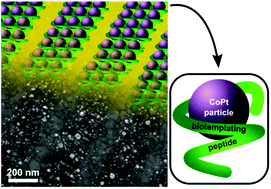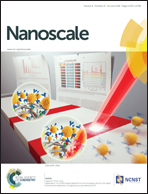Abstract
Patterned thin-films of magnetic nanoparticles (MNPs) can be used to make: surfaces for manipulating and sorting cells, sensors, 2D spin-ices and high-density data storage devices. Conventional manufacture of patterned magnetic thin-films is not environmentally friendly because it uses high temperatures (hundreds of degrees Celsius) and high vacuum, which requires expensive specialised equipment. To tackle these issues, we have taken inspiration from nature to create environmentally friendly patterns of ferromagnetic CoPt using a biotemplating peptide under mild conditions and simple apparatus. Nano-patterning via interference lithography (IL) and micro-patterning using micro-contact printing (μCP) were used to create a peptide resistant mask onto a gold surface under ambient conditions. We redesigned a biotemplating peptide (CGSGKTHEIHSPLLHK) to self-assemble onto gold surfaces, and mineralised the patterns with CoPt at 18 °C in water. Ferromagnetic CoPt is biotemplated by the immobilised peptides, and the patterned MNPs maintain stable magnetic domains. This bioinspired study offers an ecological route towards developing biotemplated magnetic thin-films for use in applications such as sensing, cell manipulation and data storage.


 Please wait while we load your content...
Please wait while we load your content...